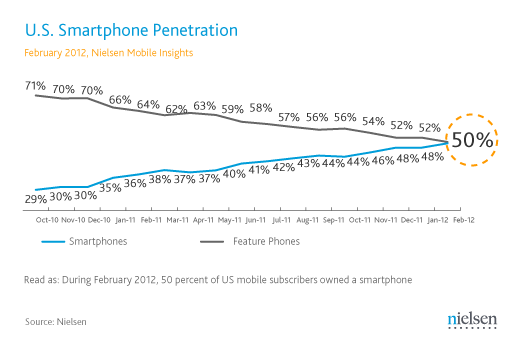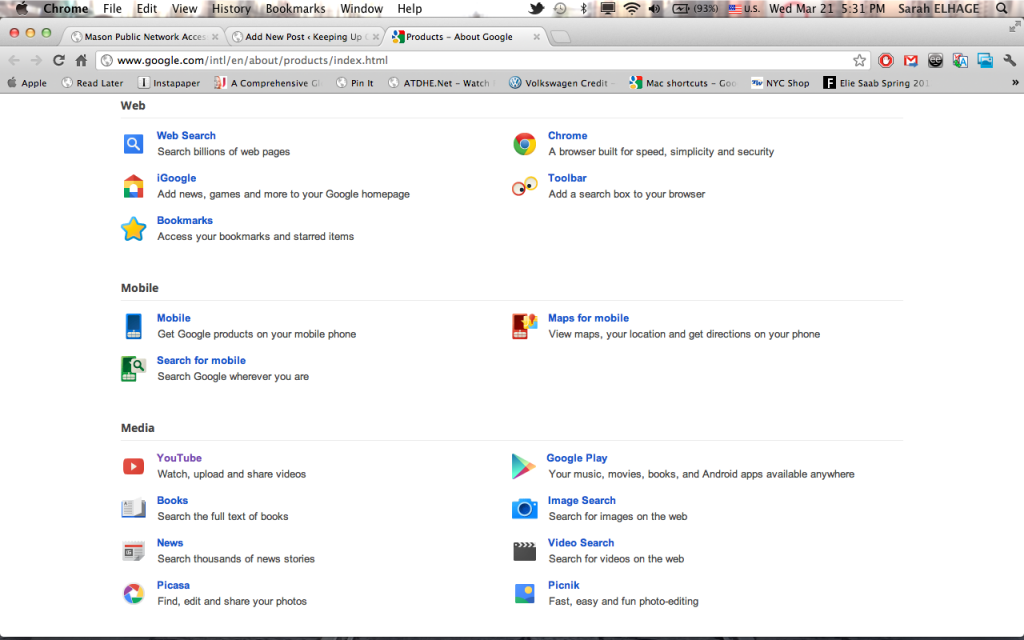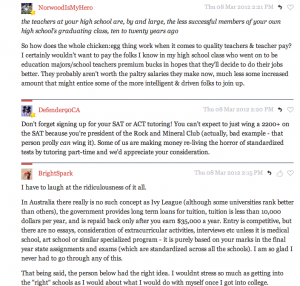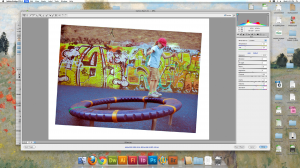The Verge: Smartphones are taking over the world
March 29, 2012
Via an article on The Verge, according to a new report from Nielsen, as of February 2012, 49.7 of US mobile owners own a smartphone. Some statistics for you:
- 48% of owners say they own a Android OS device
- 32% own an iPhone
- 12% own a BlackBerry
As for the new purchases:
- 48% bought an Android OS device
- 43% bought an iPhone
- 5% bought a BlackBerry
And some graphs for you, all via Nielsen.
When I wrote the headline, the first thing I thought of was that movie iRobot with Will Smith (I will never not see anything with Will Smith) and instead of that crazy robot, Siri is going to take over and all smartphones except iPhones will cease to exist.
But seriously, I think with the lack of regular phones on the market, the majority of people will soon have to buy one simply from lack of variety. Both my parents do not own a smartphone and to be honest, they don’t need them. I think it would be smart for a company to create a phone that doesn’t require a data plan and therefore an, extra $20-$30 on someone’s bill if they’re only going to use the Internet minimally.
Pinterest!
March 21, 2012
I’m a Pinterest novice to say the least, but now that I’m getting the hang of it, I’m more than addicted.
It’s a little overwhelming in the beginning but I’m finally starting to figure out boards, and repinning and all that jazz. Here’s a link to my Pinterest page!
http://pinterest.com/sarahelhage/
Chapter 9: How to filter
March 21, 2012
With so many outlets for news the key to keeping up to date is organization. We truly do have information overload. Between, email, newspapers, Twitter, news applications on your mobile phone, radio, television and watching/reading content online, we are always being fed new information.
What I do
I personally use the Twitter for Mac application. In the top right hand corner, there is a little Twitter bird. When that bird is blue, I know that there are new Tweets on my timeline.
Even when I’m working, I check back every few minutes or so and see what’s happening.
But if you use Twitter and follow more than a couple hundred accounts, I would suggest using TweetDeck. With this, you can filter into whatever categories that you prefer: fashion, sports, entertainment, comedians, food and so on and so forth.
Information overload
Even though I think I’m pretty caught up with new technology and I use a lot of it, I can feel very overwhelmed with all the information. With that, there is no excuse to be behind on the times. You can be that person that’s talking about Spotify a few months after it became cool or you can talk about what program your using instead of Spotify because it’s better (damn hipsters!). Pick a couple of tech blogs or websites and keep up. There is the ever popular Engadget and Mashable or the one I read, the Verge. There are no excuses!
So once you’ve figured all that out, organize your own personal feeds. We’ve talked about Twitter and using things like TweetDeck to filter your timeline. But what about your email? And calender? This is why I love Google. I can sync EVERYTHING. My calnder, my email, my documents or… all of this:
There is actually more but I will spare you that screenshot.
The point is that there are a number of tools to keep your organized. The RSS Feed is also a great tool if you feel overwhelmed by the all the blogs and/or websites you visit. Scroll through it, see what you like, what you don’t and choose what to read.
There is a lot to take in but these days but there are solutions to filter it all out and there really is no excuse to not keep up.
Chapter 8: Digital Storytelling
March 21, 2012
For every article written online, chances are there is an accompanying video. Time and time again we are told that to be a journalist, you need to be able to cross-platform including being able to produce and create videos. In chapter eight, Briggs gives a numbers of great tips and tools to help even the most novice of movie-makers and shakers a great way to start.
With a little Google search, I found this great site that breaks down a lot of the basics in short parts, great for a beginner.
“The tools have changed, but the game remains the same: visual journalism about telling compelling stories that connect an audience with subjects, people and issues. One of the most powerful types of visual journalism, video storytelling, iss surprisingly easy to learn,” wrote Briggs. Read the rest of this entry »
Chapter 11: “Journalism Next” by Mark Briggs
March 8, 2012
I think the very first thing I learned as a student of Communication at Mason that has always been taught is to “know your audience.” In every communication class I’ve taken, this has come up someway, somehow.
So once you’ve figured out who your audience is, you should probably figure out to attract them to your website or blog. Well you work on your SEO of course! What is SEO you ask? Search engine optimization. Proper tagging, categorizing, linking, titles and just the right amount of characters in your title. It all counts.
Another way to find your audience? A little self-promotion never killed anyone. Put your links on Facebook, tweet links of posts/website with the proper hashtags and get some new readers that way. Email your friends, there is no shame in doing that.
Once you’ve built a large following, don’t forget to make your content as web friendly as possible. Remember, you’re in the land of the interwebs. You need to add links (adding a title to your link is also pretty helpful and helps your SEO), photos, videos, maps, audio and other content to make people more interested and to provide as much information as possible in one post. Make whatever you’re writing about a one-stop shop! OnMason gives me the opportunity to build my SEO in the simplest ways, most blogs will do the same for you. Just look at the options I get from OnMason:
Not included is the image of tags, categories, widgets and what I can do in HTML. Also, knowing HTML is key to making your site even better than the next. You can teach yourself online!
Chapter 10: “Journalism Next” by Mark Briggs
March 8, 2012
News as a conversation is really the only way I know news. I always write about how I get most of my news online or through applications on my phone. There is almost always a place to leave a comment and start a discussion. This has it’s pros and cons. While there are many benefits to news as a conversation, Briggs writes three important ones:
- Provide transparency on the reporting process
- Enable an immediate feedback loop
- Spread awareness of news coverage through word-of-mouth marketing
Technology is constantly changing and so the way people get their news changes with it. That means if news consumers are getting their news in a different way, journalists must adapt, whether they want to or not, and provide their content in different ways on multiple platforms. Allowing readers to engage in a discussion and be proactive is key for a journalist. I think more people will be interested in reading something if they can comment on it.
Gawker has a pretty good commenting system going even though I wasn’t a fan when it first came out and they’re pretty good about keeping up with it. (I was de-starred on Deadspin because I promoted a comment that apparently didn’t contribute to the conversation, still bitter about that.) They use a tier and star system that’s served them well in my opinion but they have to do a lot of moderating.
Some of the cons I think with allowing people to discuss an article/video/photo on the Internet is dealing with the people who do nothing but try to stir the pot to just get attention, probably someone in their parents’ basement. Unfortunately, many people engage with these “trolls” but it shouldn’t take away from having an engaging, online discussion.
Briggs writes an entire section on setting guidelines for participants and what a world it would be if people actually abided by these guidelines. Journalists have a higher standard when they participate in conversations than those who do not. “I don’t see how social media is any different, as far as ethics are concerned. If a newspaper or TV station already has an ethics policy, it should apply to social media, too,” Briggs wrote. He brings up a good point but under the guise of a username, people don’t always write with ethics in mind, knowing there is no punishment. You can ban a user I guess, but unless you’re willing to ban someone’s IP address, they usually always come back.
One of my favorite places to get news is Reddit. Reddit is a social forum where people submit links, either something they’ve written or most likely a link for a great article. The comments are usually the best part of this–usually the best, most insightful comments are voted to the top and many of them are usually from different sides. I think I learn a lot just from reading their comments. They provide links, photos and whatever else they need to back up their comments so you know what to trust.
News as a conversation can be really beneficial but you have to be careful, the same way you have to be careful where you get your news from. I have learned so much from people I don’t know by the information they have written and/or linked to in online discussions and people shouldn’t distrust it just because they’re unsure. Everyone can be a journalist!
Workshop 2: Photoshop
March 8, 2012
I recently went to a Photoshop CS5 workshop here at Mason and I have to say, this class really taught me the basics of Photoshop. I have never used Photoshop before so I was pretty excited to use the program and learn a few things. And I got to use those amazing new Macs in the lab which are pretty spectacular.
The first thing I noticed was how many options and features were available to use. It was actually pretty overwhelming. Here is the toolbar you see when you open up the program.
I’m pretty sure this doesn’t even scratch the surface of what is available.
We only used a small number of the features which is pretty much all I could have handled at that point. We first opened up a photo of a car and did a few edits on that.
That was simple enough, we learned how to crop a shape, create a layer and edit only parts of the photo that we wanted.
We then edited a photo of a girl on a trampoline and used a cool tool to cover up blemishes and change the saturation. We were told to use our judgment with the saturation however, I didn’t fair so well. Everything was so yellow, whoops.
I could go on and on about the different things we did because we covered a lot in an hour and half. What I never realized was just how simple the basics are. You can just YouTube a tutorial, which I did for you, and you get this great nine minute video to help you out.
**I also love this video because the first example is a picture of the cast of Lost, which for six years, dominated my life.
All in all, I had a really good time and learned a lot and am totally taking another tutorial to learn a few more things. If someone wants to buy me Photoshop, I will happily accept!
By switching to iPads, Vancouver, Wa. has been able to save $336 per iPad used as well as decrease printing of paper to about 40% according to this Verge article. The city traded in some of the BlackBerry’s given out to employees for iPads to stop people from printing. They brought printing down from 5,371 to 3,182. Not only did they save paper and therefore money, but they also decreased their data plans, adding up to $336.
From the article,
The pilot program was fairly limited, involving a total of 54 iPads used by members of the city council, leadership team, and police department. The city says it may keep replacing BlackBerrys with iPads but has no definite plans to expand the program. As an experiment, the project shows that tablets can replace paper printouts in a way that phones and computers have not.
I think it’s great that cities are starting to branch out and trying to find different methods that not only is green and better for the environment. What I also really liked about this method is that the city was able to save money and still get the job done. Who would take an iPad over a BlackBerry? Not many, I think. I hope that Vancouver decides to follow through with this plan as it has shown to be pretty effective. Hopefully people will take notice and this will not only catch on for government but also in schools and universities.
You can always count on the Pacific Northwest for this.
Places I’ve been
March 6, 2012
View Places I’ve Been in a larger map









